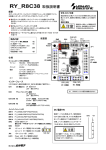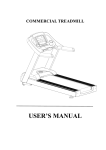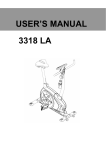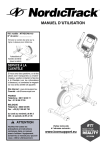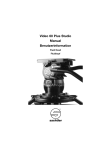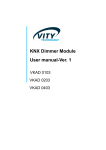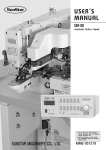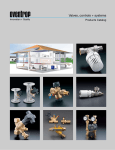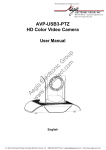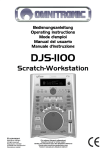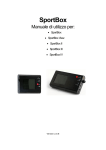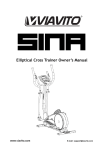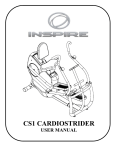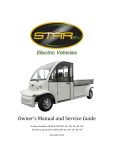Download 7318 LB USER`S MANUAL
Transcript
USER’S MANUAL 7318 LB Index Page 1. Assembly Instructions ----------------------------1.1 For your safety - - - - - - - - - - - - - - - - - - - - - - - - - - - - - - 1.2 Handling the equipment ----------------------1.3 Instructions of assembly ----------------------1.4 Order of spare parts -------------------------1.5 Checklist hardware -------------------------1.6 Checklist parts -----------------------------1.7 Assembly drawing --------------------------- 2 2 3 3 4 4 5 6 2. General - - - - - - - - - - - - - - - - - - - - - - - - - - - - - - - - - - - - - - - - 2.1 Packing ----------------------------------2.2 Disposal - - - - - - - - - - - - - - - - - - - - - - - - - - - - - - - - - - 2.3 Explanation of symbols ------------------------ 6 7 7 7 3. Assembly --------------------------------------3.1 Remove all parts from the carton ----------------3.2 Take the exercise bike out of the carton -----------3.3 Assembly steps ----------------------------3.4 Adjusting the saddle position - - - - - - - - - - - - - - - - - - - - 7 7 7 8 15 4. Placing the exercise bike --------------------------4.1 Aligning the exercise bike - - - - - - - - - - - - - - - - - - - - - - 4.2 Power supply ------------------------------4.3 Moving the exercise bike - - - - - - - - - - - - - - - - - - - - - - 4.4 Store the exercise bike - - - - - - - - - - - - - - - - - - - - - - - - - 15 15 15 15 16 5. Preparing the start -------------------------------5.1 Power supply ------------------------------5.2 Enter and leave the exercise bike ---------------- 16 16 16 6. Computer handling 6.1 Computer display and functions - - - - - - - - - - - - - - - - - 6.2 Assembly batteries - - - - - - - - - - - - - - - - - - - - - - - - - - - 16 23 7. Training manual - - - - - - - - - - - - - - - - - - - - - - - - - - - - - - - - - 7.1 Types of training - - - - - - - - - - - - - - - - - - - - - - - - - - - - 7.2 Training frequency - - - - - - - - - - - - - - - - - - - - - - - - - - 7.3 Training intensity - - - - - - - - - - - - - - - - - - - - - - - - - - - 7.4 Heart rate training - - - - - - - - - - - - - - - - - - - - - - - - - - 7.5 Training control - - - - - - - - - - - - - - - - - - - - - - - - - - - - 7.6 Warm up and cool down - - - - - - - - - - - - - - - - - - - - - - - 23 23 23 24 24 25 26 8. Maintenance -----------------------------------8.1 Maintenance - - - - - - - - - - - - - - - - - - - - - - - - - - - - - - 8.2 Care ------------------------------------ 26 26 27 9. Troubleshooting -------------------------------10. Explosion drawing - - - - - - - - - - - - - - - - - - - - - - - - - - - - - 11. Parts list - - - - - - - - - - - - - - - - - - - - - - - - - - - - - - - - - - - - - 27 28 30 1 1. Assembly Instructions Before assembling or using this exercise bike, please read the following instructions carefully. They contain important information for use and maintenance of the equipment as well as for your personal safety. Keep these instructions in a safe place for maintenance purposes or for ordering spare parts. 1.1 For your safety - - - - - - - - - - Before beginning your program of exercise, consult your doctor to ensure that you are fit enough to use this equipment. Base your program of exercise on the advice given by your doctor. Incorrect or excessive exercise may damage your health. The exercise bike should be used only for its intended purpose, i.e. for physical exercise by adult persons. Any other use of the equipment is prohibited and may be dangerous. The manufacturer cannot be held liable for damage or injury caused by improper use of the equipment. This exercise bike has been designed in accordance with the latest standards of safety. Any features which may have been a possible cause of injury have been avoided or made as safe as possible. Incorrect repairs and structural modifications (e.g. removal or replacement of original parts) may endanger the safety of the user. Damaged components may endanger your safety or reduce the lifetime of the equipment. For this reason, worn or damaged parts should be replaced immediately and the equipment taken out of use until this has been done. Use only original spare parts. If the equipment is in regular use, check all its components thoroughly every 1 – 2 months. Pay particular attention to the tightness of bolts and nuts. This is particularly true for all attached parts. To ensure that the safety level is kept to the highest possible standard, determined by its construction, this product should be serviced regularly (once a year) by specialist retailers. Instruct persons using the equipment (in particular children) on possible sources of danger during exercise. Any interference with parts of the product that are not described within the manual may cause damage or endanger the person using this machine. Extensive repair must only be carried out by specialist retailers or qualified personnel trained by manufacturer. Use only the supplied power cord. Your exercise bike is an electric product. Therefore it must be guaranteed during use that it is grounded. Please make sure that the power cord is connected with a suitable power outlet. This guarantees a reduced risk of electric shock caused by malfunction. A malfunction can cause an electric shock if the grounding has an improper connection. If you are not sure if your power outlet is suitable, please contact a qualified electrician. Never leave your exercise bike without supervision. If you leave the room, please disconnect the power cord from the power outlet. 2 - Never use the exercise bike if it is standing on a wet surface, if the power cord is defect or a 100% function of the exercise bike cannot be guaranteed. - Pay attention on enough distance of the power cord or the exercise bike from hot sources. In case of enquiry, please contact your dealer. - 1.2 Handling the equipment - - - Before using the equipment for exercise, check carefully to ensure that it has been correctly assembled. Before beginning with your first session, familiarize yourself thoroughly with all the functions and settings of the unit. It is not recommended to use or to store the unit in a damp room as this may cause it to rust. This machine is designed for use by adults and children should not be allowed to play with it. Children at play behave unpredictably and dangerous situations may occur for which the manufacturer cannot be held liable. If, in spite of this, children are allowed to use the equipment, ensure that they are instructed in its proper use and supervised accordingly. The exercise bike complies with the DIN EN 957 – 1/5, class HB. It is therefore not suitable for therapeutic use. The maximum user weight is 130 kg. A slight production of noise on the belt or brake system is due to the construction and has no negative effects upon operation. Do not use corrosive or abrasive materials to clean the equipment. Ensure that such materials are not allowed to pollute the environment. Please ensure that liquids or perspiration never enter the machine or the electronics. Before use, always check all screws and plug-in connections fit correctly. Always wear suitable shoes and clothes when using the equipment. All electric appliances emit electromagnetic radiation when in operation. Please do not leave especially radiation – intensive appliances (e.g. mobile telephones) directly next to the cockpit or the electronic control system as otherwise values displayed might be distorted (e.g. pulse measurement). The equipment requires sufficient free space in all directions (at least 1.5 m) Make certain that no other persons are in the area of your exercise bike, because they may be injured by the moving parts. The treadmill requires regularly lubrication (see 8.4). If this is not done the treadmill / motor may be damaged due to the high friction and thereby the lost of the warranty. 1.3 Instructions for assembly - - Ensure that you have received all the parts (see check list) and that they are undamaged. Should you have any cause for complaint, please contact your dealer. Unpack all individual parts and place them alongside each other on the floor. Be sure to place them on carton or a pad to prevent scratches either on the parts or on your floor. Make certain that you have adequate room for movement (at least 1 m) on all sides during assembly. Place the equipment (for assembly and use later) on a solid and flat surface. 3 - - - - Before assembling the equipment, study the drawings carefully and carry out the operations in the order shown by the diagrams. The correct sequence is given in capital letters if necessary. The equipment must be assembled with due care by an adult person. If in doubt call upon help of a second person, if possible technically talented. Please note that there is always a danger of injury when working with tools or doing manual work. Therefore please be careful when assembling this machine. Ensure that your working area is free of possible sources of danger, for example don’t leave any tools lying around. Always dispose packing material in such a way that it may not cause any danger. There is always a risk of suffocation if children play with plastic bags! The fastening material required for each assembly step is shown on the diagram inset. Use the fastening material exactly as instructed. The required tools are supplied with the equipment. Bolt all the parts together loosely at first, and check that they have been assembled correctly. Then use the Allen wrench to finally tighten the bolts completely. Then check that all screw connections have been tightened firmly. For technical reasons, we reserve the right to carry out preliminary assembly work (e.g. addition of tubing plugs) Please keep original packing of this article, so that it may be used for transport at a later date, if necessary. 1.4 Order of spare parts se - When ordering spare parts, always state the full article number, spare part number, description and quantity required. - Example order: Art. No. 7318 LB / spare part no. 12 / description / 2 pieces. - Important: spare part prices do not include fastening material ; if fastening material (bolts, nuts, washers etc.) is required, this should be clearly stated on the order by adding the words “with fastening material” 1.5 Checklist hardware No. 15 Hardware Spec. QT Y 18 M8X15 14 4 1 Spec. QT Y No . Φ10 (arc) 6 Hardware 16 M5x10 2 19 M5X10 (supplied by computer) 17 φ8 8 20 S5 wrench 4 1.6 Checklist parts No. Parts QTY No. Parts QTY 1 1 8 1 2 1 9 1 pair 3 1 10 1 4 1 11 1 5 1 12 1 6 1 13 1 7 2 14 1 1 5 1.7 Assembly drawing 2. General This training equipment is for use at home only. The equipment complies with the requirements of DIN EN 957 – 1/5 Class HB. The CE marking refers to the EU Directive 89/336/EEC and 73/23/EEC. Damage to health cannot be ruled out if this equipment is not used as intended (for example, excessive training, incorrect settings, etc.) Before starting your training, you should have a complete physical examination by your doctor, in order to rule out any existing health risks. Make the training on your new exercise bike an essential part of a healthy lifestyle, which also includes a healthy diet and motion training. Strictly adherence of this will have following effects from your training: - Muscle development and tightened thighs. - Improvement of the mobility. - Higher calorie consumption means reduced weight. - Improvement of your body shape. 6 - Invigoration of heart and lungs. Reduced stress and ageing. Increased stamina Increased capability Fortification of body’s defenses 2.1 Packing The packing consists out of environment – friendly and recyclable materials: - External packing made of cardboard - Protection layers inside made of cardboard - Moulded parts made from CFS – free polystyrol (PS) - Sheeting and bags made of polyethylene (PE) - Wrapping straps made of polypropylene (PE) 2.2 Disposal Please be sure to keep the packing for the event of repairs / warranty matters. At the end of the life cycle of the item it should not be disposed of in the normal household rubbish, it must be delivered to a special place for the recycling of electric and electronic items. All the parts are recyclable according their markings. Please ask your municipal administration where to deliver in such case. 2.3 Explanation of symbols Contains important information for prevention of serious injuries or damage to the equipment. 3. Assembly Before you start assembling, the exercise bike must have room temperature. For assembling please pay attention to the following steps. 3.1 Remove all parts from the carton except the exercise bike. Unpack all individual parts and place them alongside each other on the floor. Be sure to place them on carton or a pad to prevent scratches either on the parts or on your floor. 3.2 Take the mainframe out of the carton The mainframe is very heavy, so don’t try it alone to take it out of the carton. Please ask one person to help to move it out of the carton. Then place the mainframe on a pad to protect the floor, as without assembled foot tubes it can damage/scratch your floor. The pad should be flat and not very think, so the mainframe has a stable stand. 7 3.3 Assembly steps. 8 9 10 11 12 13 14 3.4 Adjusting the saddle position 3.4.1 Height of the saddle: Most important is the correct height of the saddle. Please fix the saddle in such a height, that, during sitting on the bike and holding the handlebar, both toes can touch the floor. The saddle tube may only be pulled out to the max. position as indicated! If you pull it out higher, the saddle tube cannot be fixed safe and you risk injuries when pedaling. 3.4.2 Horizontal saddle adjustment Adjust the height of the saddle first as described in 3.4.1. Unfasten the adjusting knob under the saddle and move the saddle slider forward or backward. Adjust it to a position, that when the pedals are in the horizontal position, your knees should be at a 90 degree angle. 3.4.3 Saddle incline adjustment Open the 2 nuts at the saddle frame work until the saddle can be turned easily. Push or pull the saddle on the tip until you reach a comfortable position. Tight both nuts again. 4. Placing the exercise bike For a pleasant feeling during exercise we recommend to place the exercise bike on a comfortable and attractive place. - Never use the exercise bike outdoors - Never place the exercise bike near open water or in rooms with high humidity. - Ensure that the power cables don’t cross walkways. If there is some carpet in your chosen room, please make sure that there is enough space between the carpet and the exercise bike. In case not then please use some pad. - Place the exercise bike with a distance of at least 1.5 m to each wall. - After long time of use you will probably find some black abrasion under your exercise bike. This is a normal wear out and doesn’t mean there is a defect. This abrasion can be removed with every standard vacuum cleaner. To prevent dirt on your carpet, please use a pad. 4.1 Aligning the exercise bike - Please take care that the floor, on which you place the equipment, must be flat and solid and should have no unevenness. - If the exercise bike doesn’t stand safe try to adjust the bike with the rear height adjustments. If the height adjustment cannot equal the floor unevenness, please position it to a different place. 4.2 Power supply - Please take care not to use a multiple power outlet in which already other appliances are connected 4.3 Moving the exercise bike To move the exercise bike to a different location please do as following - Disconnect the power cord from the power outlet. - Stand in front of the exercise bike and hold the handlebar. - Tip over the exercise bike carefully in your direction and move it on the transport rollers to your desired new location. 15 4.4 Store the exercise bike As safety measures, especially when you have children, you should take care on the following points. - Disconnect the power cord from the power outlet. - If the equipment will be long-term stored, please take off the batteries from the batteries box. 5. Preparing the start 5.1 Power supply You can drive your system from 2 power sources: External power or batteries. For external power: - Connect the power cord with the proper power outlet. o Voltage : 220V ± 10% (50 Hz or 60 Hz) The standard of voltage and the power supply are different in different countries. For your safety, please use the appropriate power adapters according standards in your country. For batteries: - Insert 4 batteries in the battery case on the back side of the computer. o Please use following type: R14C(B) Size C/1.5V Please don’t use both power supplies at once. Use either the external power supply or the batteries. 5.2 Enter and leave the exercise bike - To prevent injuries due to unbalance, please always hold the fixed handlebar when enter or leaving the exercise bike. Never step on the cover, please only use the pedals. 6. Computer handling 6.1 Computer display and functions The monitor is designed for programmable magnetic bikes and introduced with the following categories: - Key Functions - About Displays 16 - Operating Ranges - Things You Should Know Before Exercising - Operation Instructions AUTO ON /OFF: The monitor will wake up automatically if the exercise machine is in motion or you press one of the button ENTER 、 START/STOP and MODE ‧ If stop exercising over 256 seconds, monitor will turn off ‧ z Key Functions There are total 6 keys including START/STOP, ENTER, MODE, UP, DOWN, and RECOVERY. A. START/STOP: Starts or stops the program chosen. And, resets the monitor by pressing and holding for 2 seconds. B. ENTER: Chooses the functions from PROGRAMS, GENDER, TIME, HEIGHT, WEIGHT, DISTANCE, TARGET HEART RATE, AGE, and 10 columns. The chosen function shall flash. Please note that not all the functions can be selected in every program according to the types of each program. C. MODE: Changes the displays of the values between RPM or SPEED, and KJOULE/CAL or WATT. The values of RPM show at the same time, or the values of SPEED and KJOULE/CAL do by pressing it. D. UP (▲): Selects or increases the values of PROGRAMS, GENDER, TIME, HEIGHT, WEIGHT, DISTANCE, TARGET HEART RATE, AGE, and 10 columns. E. DOWN (▼): Selects or decreases the values of PROGRAMS, GENDER, TIME, HEIGHT, WEIGHT, DISTANCE, WATT, TARGET HEART RATE, AGE, and 10 columns. F. RECOVERY: Starts the function of PULSE RECOVERY. z About Display A. START: Indicates the program selected has started. B. STOP: Indicates the program selected has stopped. And, users are free to change the programs and the value of functions applied. C. PROGRAM n: Indicates the programs selected from PROGRAM 1 to PROGRAM 15 (or 17). D. LEVELn: Indicates the level of loading selected from LEVEL 1 to LEVEL 16. E. GENDER: Indicates the gender (Male or Female) selected. F. TIME/HEIGHT/WEIGHT Display: Indicates only 1 value of TIME, HEIGHT, or WEIGHT displayed depending on the programs. 17 G. RPM/SPEED/KMH (MPH) Display: Indicates only 1 value of RPM, SPEED, or KMH (MPH) displayed depending on the programs. H. DISTANCE/FAT% Display: Indicates only 1 value of DISTANCE or FAT% displayed depending on the programs. I. CAL/BMR Display: Indicates only one value of CAL, or BMR displayed depending on the programs. J. TARGET H.R./BMI/AGE Display: Indicates only one value of TARGET HEART RATE, BMI, or AGE displayed depending on the programs. K. HEART RATE/BODY TYPE Display: Indicates only one value of HEART RATE or BODY TYPE displayed depending on the programs. L. LOADING Profiles: There are 10 columns of loading bars, and 8 bars in each column. Each column represents 3 minutes workout (without the change of TIME value), and each bar represents 2 levels of loading. 18 z Operating Ranges Values PROGRAM LEVEL GENDER TIME HEIGHT (cm) WEIGHT (kg) DISTANCE TARGET H.R. AGE z Range (Count Count down up) 1 ~ 17 17 ~ 1 1 ~ 16 16 ~ 1 Male, Female N/A 0:00 ~ 99:59 99:00 ~ 5:00 110.0 ~ 199.5 199.5 ~ 110.0 10.0 ~ 199.8 199.8 ~ 10.0 0.0 ~ 999.0 999.0 ~ 1.0 60 ~ 220 220 ~ 60 10 ~ 99 99 ~ 10 Preset 1 N/A Male 0:00 175.0 70.0 0.0 90 30 Increment (Decrement) 1 1 N/A 1:00 0.5 0.2 1.0 1 1 Things You Should Know Before Exercising A. The values calculated or measured by the computer are for exercise purpose only, not for medical purpose. B. The Variables May Need To Change In The Programs: Programs Variables P1 ~ P7 TIME, DISTANCE, AGE P8 GENDER, HEIGHT, WEIGHT, AGE P9 TIME, DISTANCE, TARGET H.R. P10 ~ P12 TIME, DISTANCE, AGE P13 ~ P16 TIME, DISTANCE, AGE, 10 Intervals Please note that only 1 value of TIME or DISTANCE can be adjusted. Both adjustments do not exist at the same time. For example, the value of DISTANCE is “0.0” while the value of TIME is adjusted to be any number except “00:00”. C. Programs Selection: There are 16 programs with 1 Recovery including 1 Manual Program, 6 Preset Programs, 1 Body Fat Program, 4 Heart Rate Control Programs, 4 User Setting Programs, 1 Speed Independent Program, and 1 Pulse Recovery Measuring. D. Program Graph: Each graph shown is the profile of the loading in each interval (column). With the value of TIME counting up, each interval is 3 minutes that all the columns make up 30 minutes. With the value of TIME counting down, each interval is the value of setup TIME divided by 10. For example, if the time value is setup to 40 minutes, 19 each interval will be 40 minutes divided by 10 intervals (40/10=4). Then, each interval will be 4 minutes. The following graphs are all the profiles in the monitor. Program 1 (Manual) Program 2 (Polling) Program 3 ( Valley ) Program (Fat Burn ) Program 5 (Ramp) Program 6 (Mountain) Program 7 (Random) Program 8 (Body Fat) Program 9 (Target H.R.) Program 10 (60% H.R.C.) Program 11 (75% H.R.C.) Program 12 (85% H.R.C.) 20 Program 13 (User Setting) Program 14 (User Setting) Program 15 (User Setting) Program 16 (User Setting) E. Body Types: There are 9 body types divided according to the FAT% calculated. Type 1 (super thinner)is from 5% to 9%. Type 2(sporting and ideal) is from 10% to 14%. Type 3(super sporting) is from 15% to 19%. Type 4(sporting) is from 20% to 24%. Type 5(healthy and ideal) is from 25% to 29%. Type 6(thin) is from 30% to 34%. Type 7 (fat)is from 35% to 39%. Type 8(fatter) is from 40% to 44%. Type 9(much fatter) is from 45% to 50%. F. BMR: Basal Metabolism Ratio G. BMI: Body Mass Index z Operation Instructions A. Exercising With a Specific Goal: 1. TIME Control: Sets up a period of time to exercise. (Except in Program 8) 2. DISTANCE Control: Sets up a certain distance to exercise. (Except in Program 8) 3. BODY FAT Control: Computer designs various programs for different people with different body fat ratio. 4. WATT Control: Keeps different bodies burning in desire WATT consumed. 5. Heart Rate Control: Keeps users to exercise under a safe heart-beating condition B. Pulse Rate: The whole set of heart rate detector include 2 sensors each side. Each sensor has 2 pieces of metal parts. The correct way to get detected is to gently hold both metal parts each hand. With the good signals picked up by the computer, the heart mark in the HEART RATE/BODY TYPE Display shall flash. C. Manual Program: PROGRAM 1 is a manual program. Press “ENTER” key to select TIME, DISTANCE, and AGE. Then, press ▲ or ▼ key to adjust the values. The default level of loading is 6. After pressing “START/STOP” key to exercise, please also apply the heart rate detector appropriately. Users may exercise in any desire level (by pressing ▲ or ▼ during the workout) with a period of time or a certain distance. With the input of age, the computer may suggest a target heart rate to exercise. The suggested heart rate is 85%(220 – age). So, if the heart rate detected equals to or greater than the TARGET H.R., the value of HEART RATE will keep flashing. Please note that it is a warning for users to slow down or to lower the level of loading. 21 D. Preset Programs: PROGRAM 2 to PROGRAM 7 are the preset programs. Press “ENTER” key to select TIME, DISTANCE, and AGE. Then, press ▲ or ▼ key to adjust the values. Users may exercise with different level of loading in different intervals as the profiles show. After pressing “START/STOP” key to exercise, please also apply the heart rate detector appropriately. Users may also exercise in any desire level (by pressing ▲ or ▼ during the workout) with a period of time or a certain distance. With the input of age, the computer may suggest a target heart rate to exercise. The suggested heart rate is 85%(220 – age). So, if the heart rate detected equals to or greater than the TARGET H.R., the value of HEART RATE will keep flashing. Please note that it is a warning for users to speed down or to lower the level of loading. E. Body Fat Program: Program 8 is a special program designed to calculate users’ body fat ratio and to design a specific loading profile for users. With 9 different body types, the computer can generate 9 different profiles for each. Press “ENTER” key to select GENDER, HEIGHT, WEIGHT, and AGE. Then, press ▲ or ▼ key to adjust the values. After pressing “START/STOP” key to calculate body fat, please also apply the heart rate detector appropriately. If the detector cannot pick up any signals, an error message “E3” will show up in the profile display. If it happens, press “START/STOP” key to calculate again. Then, the calculation values of FAT%, BMR, BMI, BODY TYPE, and a designed profile will show up shortly. Press “START/STOP” key to exercise. The profile shown in the display is specially designed for your body type. F. Heart Rate Control Programs: Program 9 to Program 12 are the Heart Rate Control Programs. In program 9, press “Enter” key to select TIME, DISTANCE, and TARGET H.R. Users may setup a target heart rate to exercise in a period of time or a certain distance. In Program 10 to Program 12, press “Enter” key to select TIME, DISTANCE, and AGE. Then, press ▲ or ▼ key to adjust the values. Users may exercise in a period of time or a certain distance with 60% Max Heart Rate in Program10, 75% Max Heart Rate in Program 11, and 85% Max Heart Rate in Program 12. After pressing “START/STOP” key to exercise, please also apply the heart rate detector appropriately. In these programs, the computer will adjust the level of loading according to the heart rate detected. For example, the level of loading may increase while the heart rate detected is lower than TARGET H.R. Also, the level of loading may decrease while the heart rate detected is higher than TARGET H.R. As a result, the user’s heart rate will be adjusted to close the TARGET H.R. in the range of TARGET H.R. –5 and TARGET H.R. +5. G. User Setting Programs: Program 13 to Program 16 are the user-setting programs. Users are free to edit the values in the order of TIME, DISTANCE, AGE, and the level of loading in 10 intervals. The values and profiles will be stored in the memory after setup. After pressing “START/STOP” key to exercise, please also apply the heart rate detector appropriately. Users may also change the ongoing loading in each interval by pressing ▲ or ▼ key, and they will not change the level of loading stored in the memory. With the input of age, the computer may suggest a target heart rate to exercise. The suggested heart rate is 85%(220 – age). So, if the heart rate detected equals to or greater than the TARGET H.R., the value of HEART RATE will keep flashing. Please note that it is a warning for users to speed down or to lower the level of loading. 22 H. Pulse Recovery: It is a function to check the condition of pulse recovery that is scaled from 1.0 to 6.0 while 1.0 means the best and 6.0 means the worst and the increment is 0.1. In order to get rated correctly, users must test it right after the workout finished by pressing “RECOVERY” key and then stop exercising. After the key is pressed, please also apply the heart rate detector appropriately. The test will last for 1 minute and the result will show in the display. 6.2 Assembly of batteries box Firstly take off the cover of batteries box which on the back of computer. Secondly, please assemble the batteries according the symbol in the batteries box (as following picture). Pay attention to the anode and cathode. Finally, check if all of batteries assemble in right position, then cover the batteries box. After cut down the external power supply, please pull out the power adapter from the mainframe, otherwise the computer could not work when you use the batteries. 7. Training manual Training with an exercise bike is ideal movement training for strengthening important muscle groups and the cardio – circulatory system. General notes for training - Never do exercise immediately after a meal - If possible, orient your training to pulse rate - Do muscle warm – ups before starting by loosening or stretching exercises - When finish your training, please reduce speed. Never abruptly end your training. - Do some stretching exercises when finished with your training. 7.1 Training frequency To improve your physical fitness and to enhance your stamina over the long term, we recommend training at least three times a week. This is the average training frequency for adults in order to obtain long time stamina success or high fat burning. As your fitness level increases, you also can train daily. It is particularly important to train at regular intervals. 7.2 Training intensity Carefully structure your training. The intensity should be increased gradually, so that no fatigue of the musculature or the locomotors system occurs. 23 RPM In terms of a targeted endurance training in principle it is recommended to select rather a lower resistance and to exercise at a higher rpm (revolutions per minute). Ensure that the rpm is higher than 80 RPM but does not exceed 100 RPM. 7.3 Heart rate training For your personal pulse zone it is recommended that an aerobic training range is chosen. Performance increases in the endurance range are principally achieved by long training units in the aerobic range. Find this zone in the target pulse diagram or orient yourself on the pulse program. You should complete 80% of your training in this aerobic range (up to 75% of your maximum pulse). In the remaining 20% of the time, you can integrate load peaks, in order to shift your aerobic threshold value upwards. With the resulting training success you can later produce higher performance at the same pulse: this means an improvement in your physical shape. If you already have some experience in pulse – controlled training you can match your desired pulse zone to your special training plan or fitness status. Note: Because there are persons which have “high” and “low” pulses, the individual optimum pulse zones (aerobic zone, anaerobic zone) may differ from those of the general public (target pulse diagram). In these cases, training must be configured according to individual experience. If beginners are confronted with this phenomenon, it is important to consult a doctor before start training, in order to check your health capacity for training. Generally we recommend that everyone first consults a doctor, before doing any fitness training. 7.4 Training control Both medically and in terms of training physiology, pulse – controlled training makes most sense and is oriented on the individual maximum pulse. This rule applies to beginners, ambitious recreational athletes and to professionals. Depending on the goal of training and performance status, training is done at a specific intensity of individual maximum pulse (expressed in percentage points). In order to effectively configure cardio – circulatory training according to sports – medical aspects, we recommend a training pulse rate of 70% - 85% of maximum pulse. Please refer to the following target pulse diagram. Measure your pulse rate at the following points in time: 1. Before training = resting pulse 2. 10 minutes after training start = training / working pulse 3. 1 minute after training = recovery pulse - - During the first weeks, it is recommended that training is done at a pulse rate at the lower limit of the training pulse zone (approximately 70% or lower) During the next 2 – 4 months, intensify your training stepwise until you reach the upper end of the training pulse zone (approximately 85%) but without overexerting yourself. Although you are in a good condition, disperse easier units in the lower aerobic range time and again in your training program, so that you regenerate sufficiently. 24 A “good” training always means intelligent training, which includes regeneration at the right time. Otherwise overtraining results and your condition worsen - Every loading training unit in the upper pulse range of your individual performance should always be followed in subsequent training by a regenerative training unit in the lower pulse range (up to 75% of the maximum pulse). When your condition has improved, higher intensity of training is required for the pulse rate in order to reach the “training zone”, that is, that the organism is capable of higher performance. Calculation of the training / working pulse 220 pulse beats per minute minus age = personal, maximum heart rate (100%) Training pulse Lower limit: (220 – age) x 0.70 Upper limit: (220 – age) x 0.85 7.5 Training duration Every training unit should ideally consist a warm – up phase, a training phase and finally a cool – down phase in order to prevent injuries. Warm up: 5 – 10 minutes of calisthenics or stretching (also slow cycling). Training: 15 – 40 minutes of intensive but not overextended training at the intensity mentioned above. Cool – down: 5 – 10 minutes of slow cycling, followed by calisthenics or stretching, in order lo loosen the muscles. Stop training immediately if you feel unwell or if any signs of exhaustion occur! Alterations of metabolic activity during training: - In the first 10 minutes of endurance performance our bodies consumes the sugar stored in our muscles: Glycogen. - After about 10 minutes additionally fat will be burned. - After 30 – 40 minutes fat metabolism is activated, and then the body’s fat is the main source of energy. - 25 7.6 Warm up and cool down Warming up is an important part of your workout and should begin every session. It prepares your body for more strenous exercise by heating up and stretching your muscles, increasing your circulation and pulse rate, and delivering more oxygen to your muscles.At the end of your workout, repeat these exercises to reduce sore Muscle problems. We suggest the following warm-up and cool-down Exercises: 1. Toe Touch Slowly bend forward from your waist, letting your back and Shoulders relax as you stretch toward your toes. Reach down as far as you can and hold for 15 counts. 2. Hamstring Stretch Sit with your right leg extended. Rest the sole of your left foot against your right inner thigh. Stretch toward your toe as far as possible. Hold for 15 counts. Relax and then repeat with left leg extended. 3. Calf-Achilles Stretch Lean against a wall with your left leg in front of the right and your arms forward. Keep your right leg straight and the left foot on the floor;then bend the left leg and lean forward by moving your hips toward the wall. Hold, then repeat on the other side for 15 counts. 4.Quadriceps Stretch Put your right hands on the wall, the left hand backward catch the left foot. Let your heel stretch toward to your buttocks as close as you can and hold for 15 counts. Relax and then repeat with right foot. 5. Inner Thigh Stretch Sit with the soles of your feet together with your knees pointing outward. Pull your feet as close into your groin as possible. Gently push your knees towards the floor. Hold for 15 counts. Start your stretch slowly, exhaling as you gently stretch the muscle. Don’t bounce when you stretch. Holding a stretch offers less chance of injury.. Don’t strain or push a muscle too far. If it hurts, ease up. 8. Maintenance 8.1 Maintenance - In principle, the equipment does not require maintenance. Regularly inspect all parts of the equipment and the if all screws and connections are tightened. Promptly replace any defective parts through customer service. Don’t use the equipment until it is repaired. 26 8.2 Care - When cleaning use only a moist cloth and avoid harsh cleaning agents. Ensure that no moisture penetrates the computer. - Components (handlebar, saddle) that come in contact with perspiration, need cleaning only with a damp cloth. Please ensure that liquids never enter the machine or the electronics! 9. Troubleshooting Display shows no values: - Remove the power cord from the power outlet. - Check the cable connections you assembled before. - Check if the cables have been damaged during assembly. - If cables have been damaged please order new ones from the customer service and replace the defect ones. Display shows incorrect or no pulse rate: - The hand pulse sensors are only working if you hold both sensors at the same time. - Make sure that you have a firm grip on both hand pulse sensors. - If the contact is interrupted during exercise, the computer needs a few seconds to get the new measures from the sensors. 27 10. Explosion drawing 28 29 11. Partslist Pos. # 1 2 3* 4 5 6 7* 8 Description computer Handlebar frame Seat cushion Support frame of seat cushion Handlebar post cover Mainframe Rear foot cap Rear foot tube Specification / Remarks SD-16V ABS PVC 1/2″axes Quantity 1 1 1 1 1 1 2 1 9* 10 11 12* 13* 14* Pedal Front foot tube frame Handlebar post Bottle Bottle holder Adjusting knob BLA01 1 1 1 1 1 1 15 Arc-washer φ10 6 16 Bolt, round head M5×10 2 17 washer φ8 8 18 Bolt, round head M8×15 14 19 20 21 Philips screw nut Sensor fixed plate M5×10 M3 zincification 2 2 1 22 Philips screw, round head ST3.5×13 6 23 24* washer motor φ5 2 1 25 26 27 Bolt, round head sensor Inducive magnet M3×10 2 1 1 28 29 30 31 32 33* 34* 35* 36 37 Philips screw, round head Crank cover Maiframe cover(L) Ball bearing locknut Ball bearing washer Ball bearing holder cover Ball bearing Balll bearing holder Fixed cable plug of external power supply Mainframe structure ST4.2×16 11 2 1 1 1 2 2 2 1 1 700ml argentate Computer system 30 PVC ABS 38 Locknut of external power supply 1 39* Even ellipse hollow tube cap PT80×40 1 40* 41 Motor belt Single crank 420J6(1073mm) 1 1 42* 43 44 45* 46 47 48 49 Belt wheel Mainframe cover(R) Bearing circlip Bearing Bearing washer Pressure wheel bracket Pressure wheel bearing spring φ260(hexangular) 50 51 washer Locknut φ10 52 53 54 55 Magnetism control freewheel Ball bearing washer Lock washer of inductive cable Lock bolt of inductive cable φ274×37(unilateralism) 1 1 1 1 56 57 58 Philips screw, round head handlebar Hand pulse sensor ST4.2×19 2 1 2 59* 60 Sponge bushing Seat cushion support tube φ24.5×3×620(sealed) 2 1 61 62 Tube cap Seat cushion transverse adjusting tube PVC38×38×2 black 2 1 63 64 65 66* Adjusting knob Transverse tighten plate of seat cushion Front foot tube Moveable tube cover φ60×M10 通孔 1 1 1 2 Distance 195mm ABS 17 6000 12 M10 PE16 Parts marked with * are wear out parts which are subject to natural wear out and which must be replaced after intensive or long use. In this case please contact your customer service. There you can request the parts and be charged for them. 31 1 1 1 2 1 1 1 1 4 2
































